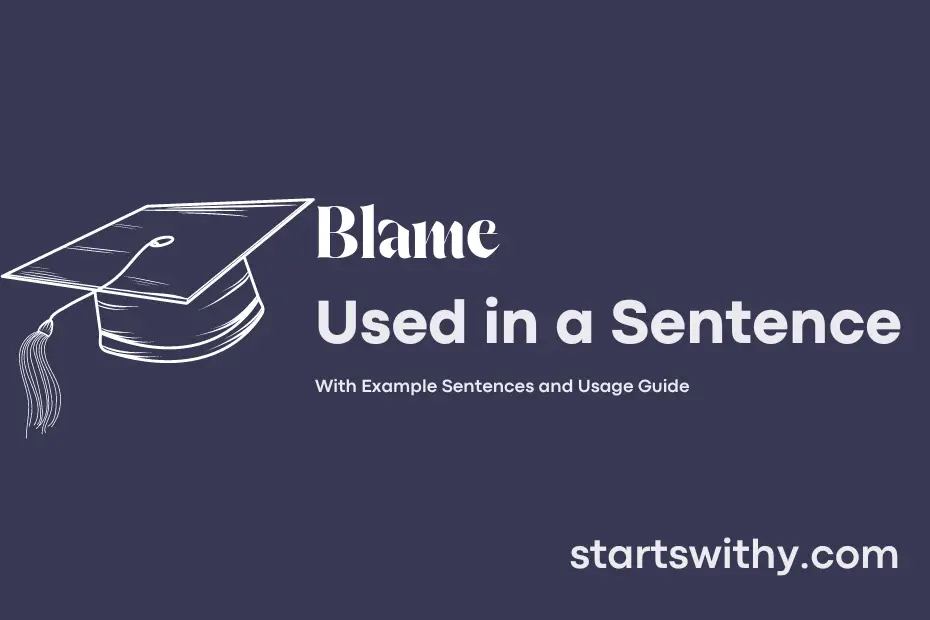Blame is the act of holding someone responsible for a fault or mistake. It involves attributing a negative outcome or consequence to a particular person or group.
In social contexts, blame can lead to feelings of guilt, resentment, or conflict among individuals. Understanding the nuances of blame and its impact on relationships is crucial for effective communication and problem-solving.
7 Examples Of Blame Used In a Sentence For Kids
- Blame the rain for making the road muddy.
- Don’t blame the cat for knocking over the vase.
- We shouldn’t blame our friends for our mistakes.
- Blame the wind for blowing away your hat.
- Don’t blame the sun for making it too hot.
- Let’s not blame the teacher for giving us homework.
- Blame the dog for eating your sandwich.
14 Sentences with Blame Examples
- Blame for the unsuccessful event registration can be attributed to the lack of promotion on social media.
- Students often blame their professors for giving them low grades, without considering their own lack of effort.
- When group projects fail, it’s common for members to blame each other instead of taking responsibility for their own contributions.
- Some students blame the college administration for not providing enough resources, rather than seeking solutions themselves.
- It’s easy to blame the weather for missing classes, but it’s important to prioritize academic responsibilities.
- Student leaders often blame apathy among the student body for low participation in campus events.
- Instead of accepting personal responsibility, some students blame the academic system for their struggles.
- When faced with failure, it’s important not to automatically blame external factors and reflect on personal growth opportunities.
- Some students blame their peers for distracting them from studying, rather than focusing on time management.
- Procrastination often leads students to blame lack of time for their incomplete assignments.
- It’s common for college students to blame their busy schedules for neglecting self-care practices like exercising and eating well.
- During exams, students may blame the difficult questions for their performance, rather than preparing thoroughly.
- Some students blame their parents for pressuring them to pursue certain career paths, instead of taking charge of their own decisions.
- In group discussions, it’s crucial not to blame others for differing opinions, but to engage in respectful dialogue.
How To Use Blame in Sentences?
Blame is a versatile word that is commonly used in conversations and writing to assign responsibility or fault for a particular situation. Here is a helpful guide on how to use Blame in a sentence for beginners:
-
Subject + “Blame” + Object: Start your sentence with the person or thing being blamed (subject), followed by the word “blame,” and end with the person or thing that is responsible (object). For example: “She blamed her sister for breaking the vase.”
-
Blame + Subject + for + Object: This structure is often used when assigning fault. Begin with the word “blame,” followed by the person being blamed (subject), then “for,” and end with the situation or action the person is being blamed for. For example: “Blame the teacher for the confusion in class.”
-
Blame + Object + on + Subject: Use this format to attribute responsibility for a situation or action. Start with the word “blame,” followed by the situation or action (object), then “on,” and end with the person or thing being blamed (subject). For example: “Blame the weather on the climate change.”
Remember that Blame can be used in different tenses and forms based on the context of the sentence. Practice using Blame in sentences to become more comfortable with its usage in conversations and writing.
Conclusion
In summary, blame is a powerful tool in language used to attribute responsibility or fault to someone or something. It is often employed in various contexts, such as personal relationships, work environments, and legal proceedings, to assign accountability for negative outcomes or mistakes. Sentences with blame can help clarify who is seen as responsible for a particular situation or problem, shedding light on the dynamics between individuals or groups.
By analyzing and understanding sentences containing blame, we can gain insight into societal norms, communication patterns, and power dynamics. Acknowledging the presence of blame in language can also prompt us to reflect on its impact on relationships, self-perception, and conflict resolution. Ultimately, the use of blame in sentences plays a significant role in shaping our perceptions and interactions with others, highlighting the complexity and nuances of human communication.



